Wellness App Design
Enhancing Mental Wellness Through Voice Analysis Technology - Creating a comprehensive wellness platform that leverages cutting-edge voice analysis while addressing privacy concerns in a competitive market.
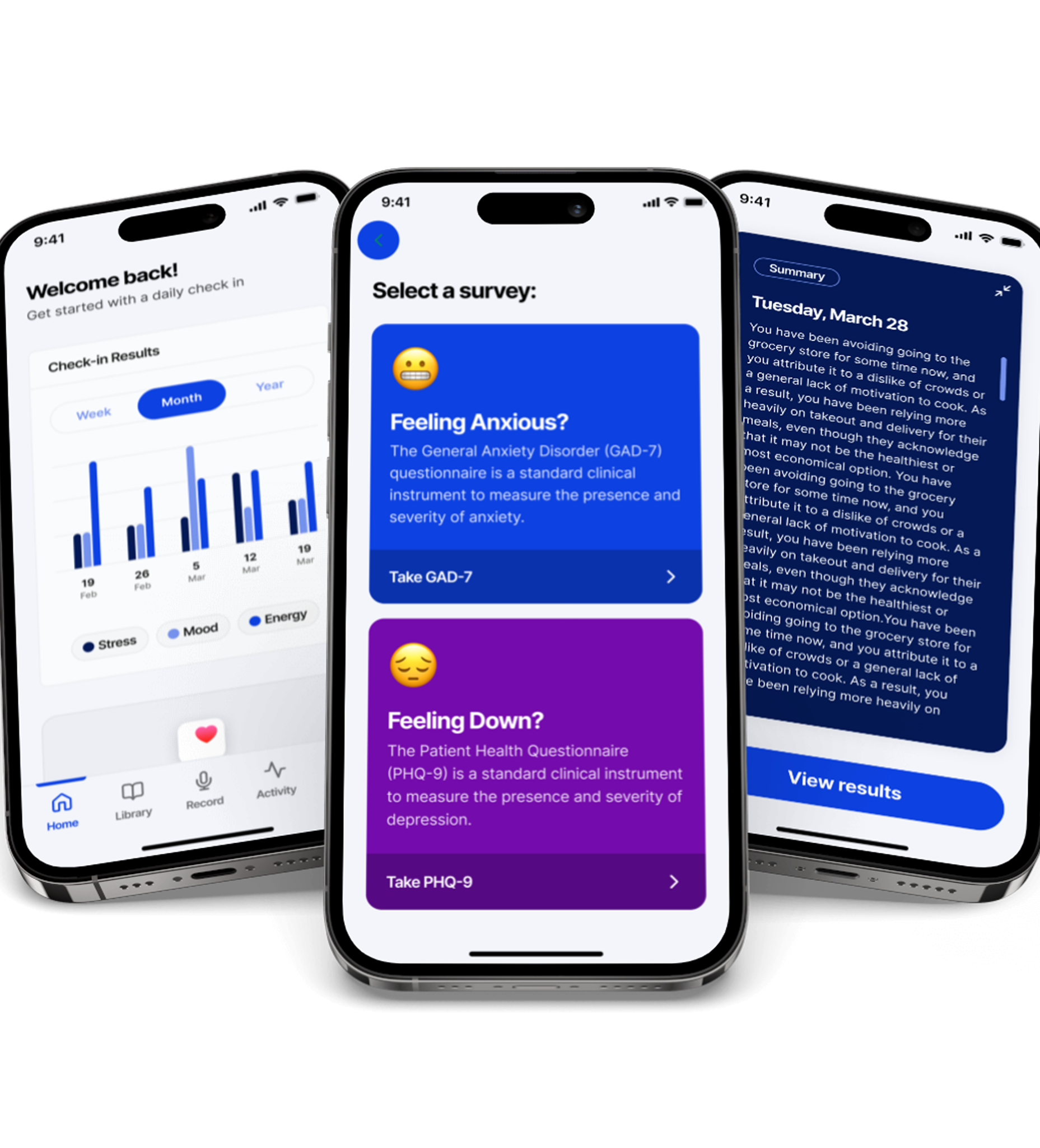
Project Impact
Validated voice analysis integration with exceptional user acceptance
Project Context
Project Goal
Create a comprehensive wellness app that leverages voice analysis technology to provide personalized mental health insights while addressing user privacy concerns and competing in a saturated market.
Tools & Methods
The Challenge
How might we create a comprehensive wellness app that leverages voice analysis technology to provide personalized mental health insights while addressing user privacy concerns and competing in a saturated market?
Market Context
The wellness app market is dominated by single-purpose solutions (Headspace for meditation, MyFitnessPal for nutrition), leaving users juggling multiple apps. Meanwhile, emerging voice analysis technology offers unprecedented opportunities for mood tracking, but user adoption faces significant privacy barriers.
Market Challenges
- •$4.2B saturated wellness app market
- •Fragmented single-purpose solutions
- •User privacy concerns with voice technology
- •Low user retention in wellness apps
Business Goals
- •Stand out in competitive market
- •Integrate cutting-edge voice analysis
- •Address all 8 pillars of wellness
- •Achieve >4.0 user satisfaction rating
Research & Market Validation
Comprehensive Wellness Competitor Survey Analysis
To validate our assumptions and understand the competitive landscape, we conducted a comprehensive survey of 95 wellness app users. This data-driven approach revealed critical insights about market gaps, user behaviors, and opportunities for our voice analysis wellness platform.
Demographics Profile
Gender Distribution
Female-dominated audience indicates strong wellness engagement
Income Distribution
High earning potential indicates premium wellness market
Education Level
Highly educated demographic suggests sophisticated wellness needs
Key Demographic Insights
Wellness Practices Landscape
Weekly Wellness Practice Adoption Rates
71 people
56 people
55 people
51 people
48 people
48 people
48 people
40 people
Practice Insights
Digital Tool Adoption & Market Gaps
Top Wellness Apps Usage
98% App Adoption Rate
Nearly universal digital wellness engagement validates our market
Market Opportunity Analysis
Key Opportunity
High app fragmentation suggests room for integrated wellness platform that combines tracking, meditation, and stress management through innovative voice analysis.
Research Validation & Strategic Insights
Validated Insight
98% app adoption indicates high digital engagement
Strategic Impact:
Strong market validation for digital wellness solutions
Validated Insight
Stress management is top priority (59%)
Strategic Impact:
Voice analysis positioning as stress-relief tool validated
Validated Insight
App fragmentation ('Something else' - 35 mentions)
Strategic Impact:
Opportunity for integrated wellness platform
Validated Insight
Educated, affluent demographic
Strategic Impact:
Matches target persona for premium wellness solutions
Quantitative Research
- 95 survey responses across 36 wellness-related questions
- 7 key areas analyzed: Demographics, tech usage, lifestyle
- Wellness frequency and impact assessment
- Tools analysis and general app behaviors
Qualitative Research
- 12 in-depth interviews with target demographic
- Voice stress analysis sessions to test concept
- Competitive app analysis and feature gaps
- User journey mapping and pain point identification
User Personas
Based on research insights, I developed three primary personas to guide design decisions and feature prioritization.
Sarah
The Busy Professional
Demographics
Age: 28-35 | Tech-savvy | Time-constrained
Goals
- • Quick stress relief
- • Efficient wellness tracking
Frustrations
- • Too many apps to manage
- • No time for complex routines
Voice Analysis Attitude
Curious but privacy-concerned
Michael
The Wellness Enthusiast
Demographics
Age: 25-40 | Health-focused | Early adopter
Goals
- • Comprehensive wellness tracking
- • Data insights and analytics
Frustrations
- • Fragmented solutions
- • Lack of personalization
Voice Analysis Attitude
Excited about innovation
Lisa
The Wellness Beginner
Demographics
Age: 35-50 | Cautious adopter | Needs guidance
Goals
- • Simple wellness habits
- • Gentle introduction to wellness
Frustrations
- • Overwhelming options
- • Technical complexity
Voice Analysis Attitude
Skeptical but open to education
User Journey Mapping
Based on our research and persona insights, I mapped the complete user journey from initial engagement through habit formation. This comprehensive journey map reveals critical touchpoints, emotional states, and opportunities for our voice analysis wellness platform.
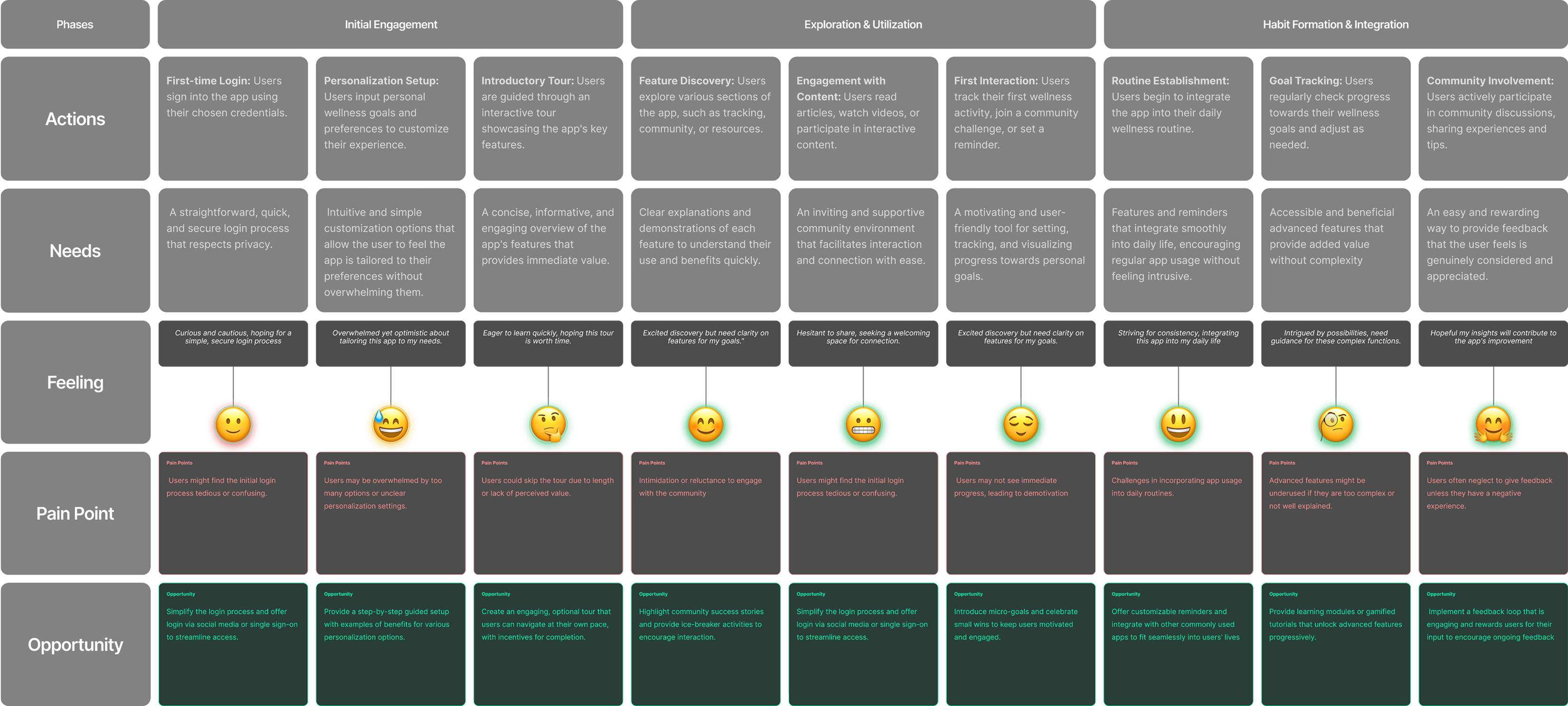
Key Journey Insights
- •Privacy concerns peak during initial voice setup, requiring careful onboarding design
- •Exploration phase is critical for feature discovery and value demonstration
- •Routine establishment needs consistent motivation and progress tracking
- •Community integration emerges as key factor for long-term engagement
Design Opportunities
- •Simplified onboarding with step-by-step voice feature introduction
- •Interactive discovery tools to showcase app capabilities organically
- •Progress gamification to maintain engagement during habit formation
- •Community features that respect privacy while enabling connection
Design Process & Solutions
Through iterative design and testing, I developed comprehensive user flows, information architecture, and innovative solutions that balance cutting-edge voice technology with user privacy concerns.
User Flow Design
Three comprehensive user flows designed to guide users through onboarding, wellness assessments, and voice analysis features while maintaining privacy and trust.
Onboarding Flow
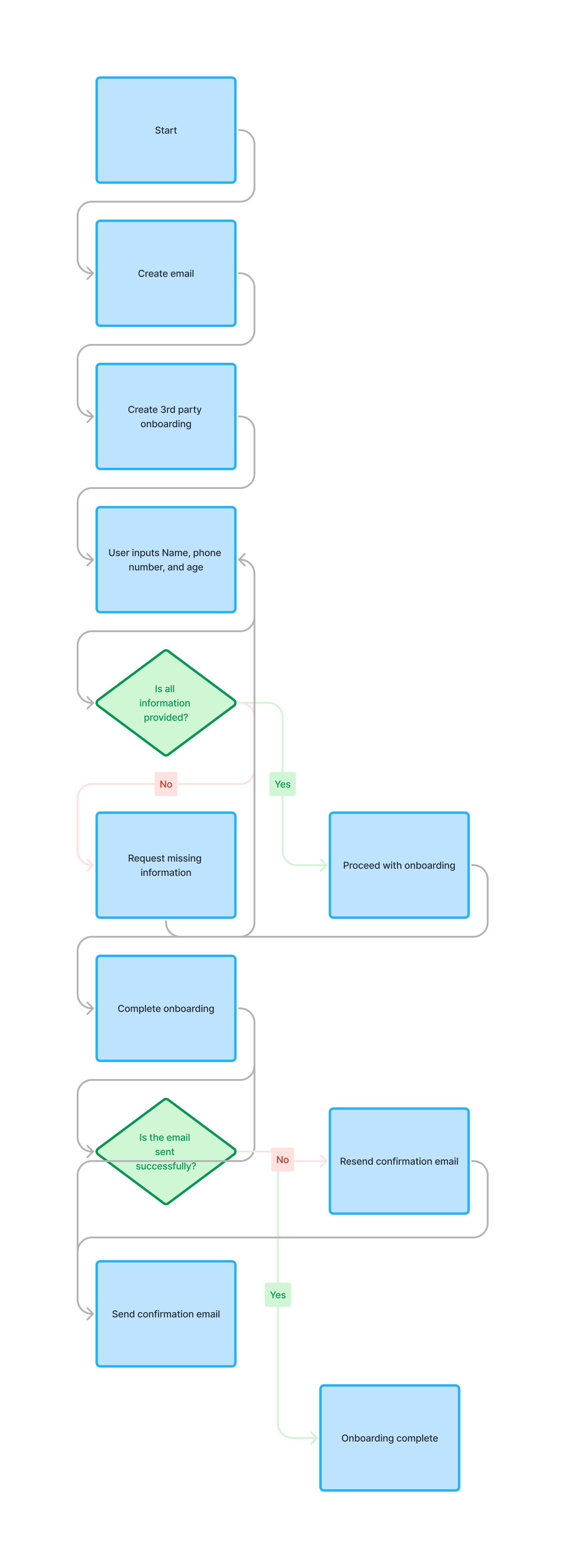
Key Features
- • Progressive information collection
- • Privacy education & transparency
- • Optional voice setup
- • Immediate value delivery
Wellness Assessment

Clinical Integration
- • GAD-7 & PHQ-9 assessments
- • Adaptive questioning logic
- • Personalized recommendations
- • Professional referral pathways
Voice Analysis Process
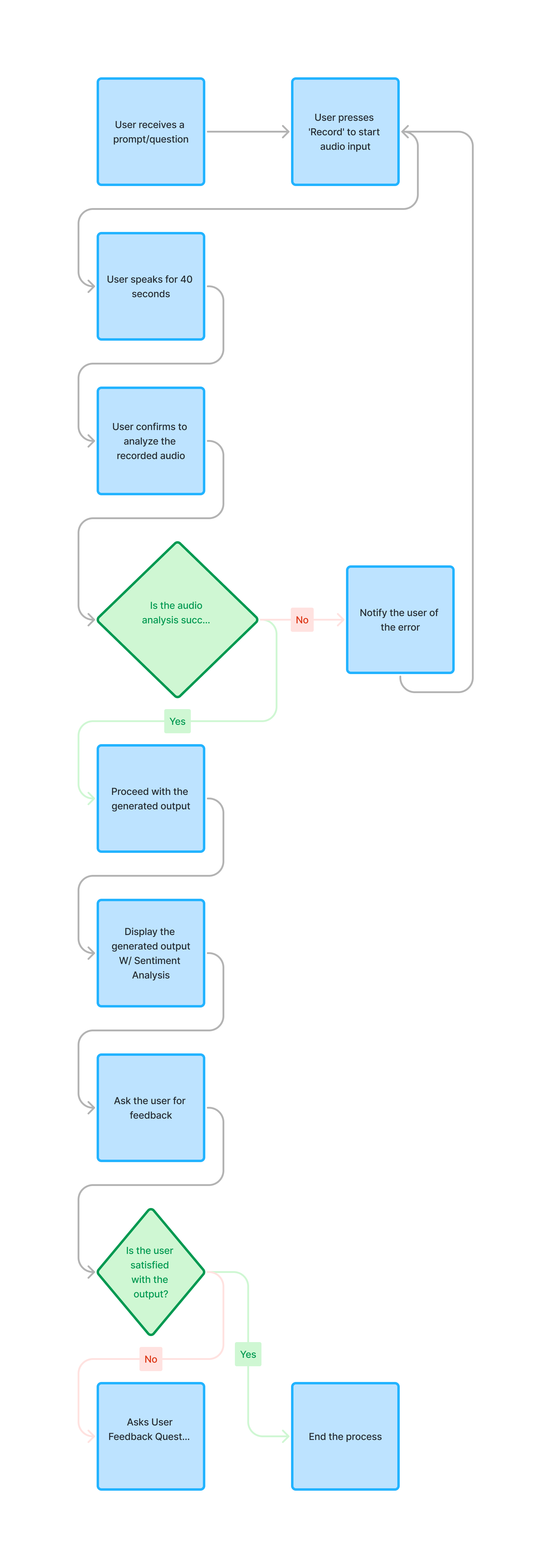
Privacy & Innovation
- • 40-second voice sessions
- • Real-time sentiment analysis
- • User consent & control
- • Feedback loop integration
Flow Design Impact
Information Architecture Design
The information architecture was designed to support both novice and expert users, with clear navigation paths and logical feature grouping that accommodates the complexity of voice analysis integration.
Architectural Principles
- •Progressive Disclosure: Advanced features accessible after core setup
- •Logical Grouping: Related wellness features organized by category
- •Escape Routes: Multiple paths back to core functionality
- •Privacy Controls: Easy access to data management features
Navigation Strategy
- •Tab-Based Primary Navigation: Wellness pillars as main sections
- •Voice Features Integration: Embedded within relevant wellness contexts
- •Quick Actions: Common tasks accessible from any screen
- •Personalized Dashboard: Adaptive interface based on user preferences
Design Principles Established
Privacy by Design
Transparent data handling
Progressive Disclosure
Gradual feature introduction
Emotional Intelligence
Voice analysis integration
Holistic Wellness
All 8 pillars addressed
Accessible Innovation
Complex tech made simple
Design System Foundation
Design Methodology
Our design methodology is rooted in cognitive psychology and aesthetics, ensuring that every element serves a purpose. We prioritize clarity, ease of use, and intuitive structures to enhance user engagement and satisfaction.
Emotional Design System
Comprehensive emoji system supporting mood tracking and emotional expression throughout the user journey.
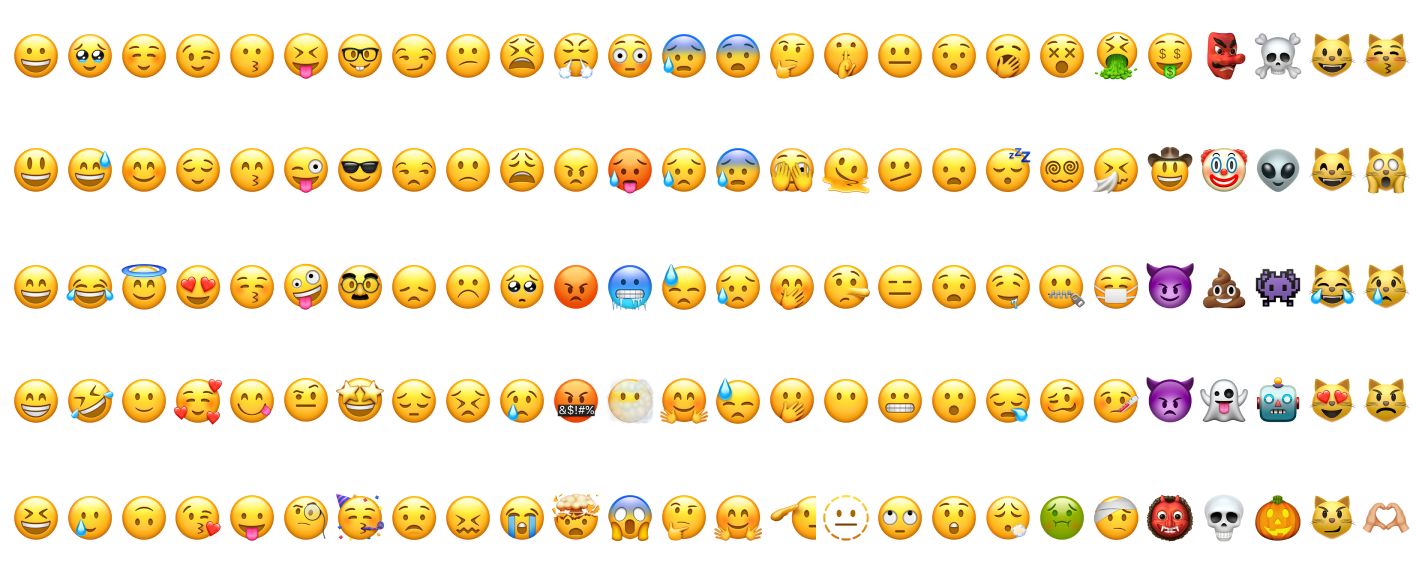
Iconography System
Phosphor Icons provide consistent visual language with optimal clarity and accessibility across all interface elements.
Color Palette
This palette reflects our brand's ethos, combining serenity with energy. The deep blue evokes reliability and strength, while the lighter shades provide a refreshing balance, facilitating a visual hierarchy essential for user navigation.
Typography
San Francisco Pro Display
Primary typeface for iOS native feel
Navigation Design
Bottom Navigation Implementation
iOS-style bottom navigation using Phosphor Icons with clear visual hierarchy and accessibility
Navigation Structure
- • Home: Dashboard & wellness overview
- • Library: Content & educational resources
- • Record: Voice analysis capture
- • Activity: Progress tracking & insights
- • Profile: Settings & personalization
Design Principles
- • Active state indication with royal blue
- • Clear visual hierarchy with opacity states
- • Phosphor Icons for consistency
- • Accessible tap targets (44pt minimum)
- • Clean label typography
Technical Implementation
- • React Navigation with custom tab bar styling
- • Phosphor Icons library integration
- • Smooth state transitions and animations
- • Platform-specific adaptations (iOS/Android)
- • Voice recording state management in tab context
Component Library
- Voice Interface Components - Custom-designed for comfortable interaction
- Progressive Onboarding - Multi-step with clear value communication
- Wellness Tracking Cards - Modular design for different wellness pillars
- Privacy Controls - Transparent permission management
- Bottom Navigation - Core app functionality access
- Emotional State Indicators - Visual mood tracking system
Key Design Solutions
Privacy-First Voice Onboarding
Challenge: Users concerned about microphone permissions
Solution: Created educational flow explaining voice analysis benefits with clear opt-out options
Design Decisions:
- • Step-by-step permission explanation
- • "Try it first" demo without recording
- • Granular privacy controls
- • Clear data usage statements
User Flow:
- • Email creation and account setup
- • Third-party integration options
- • Progressive information collection
- • Voice feature introduction sequence
Privacy Permission Flow:
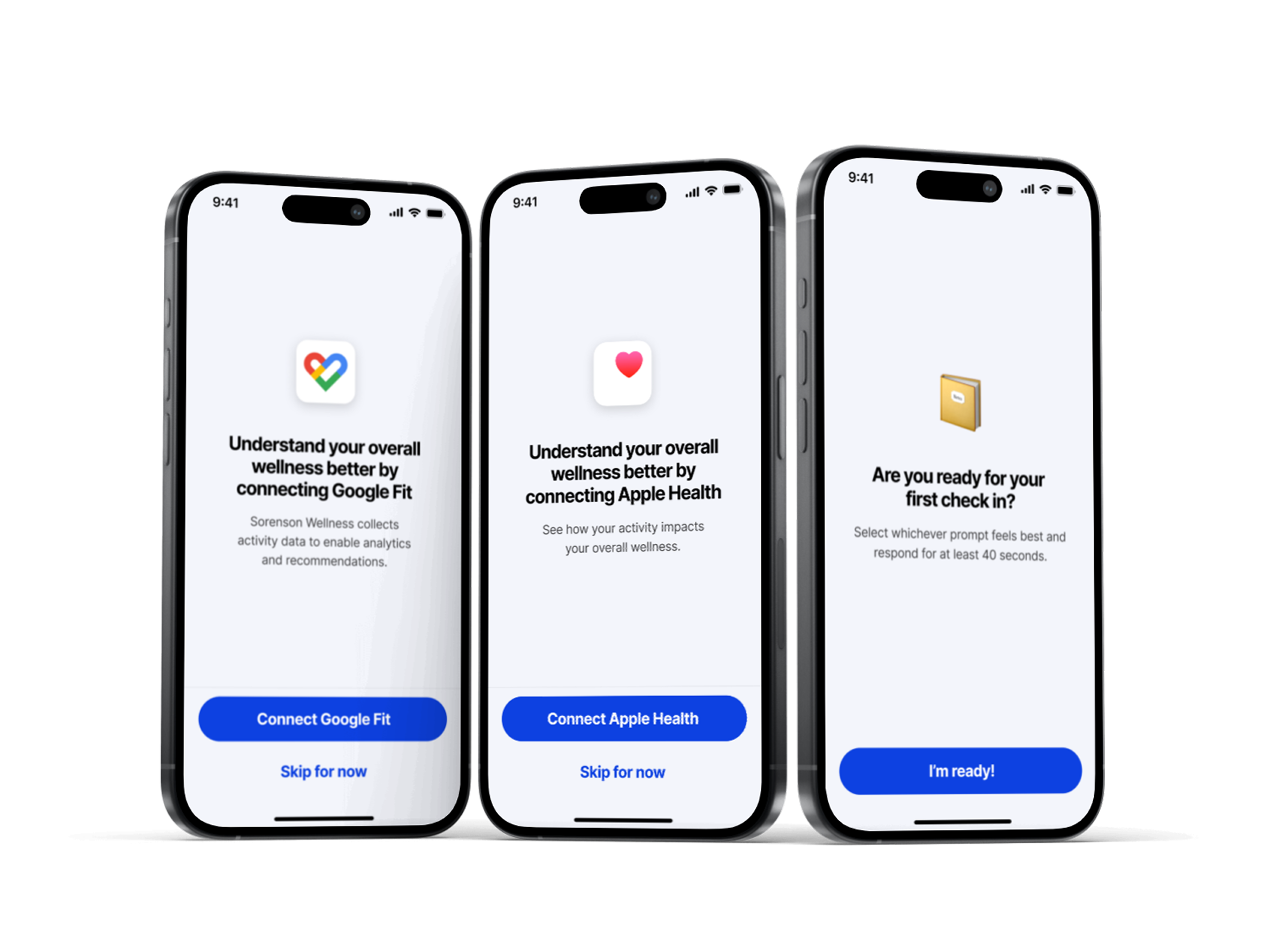
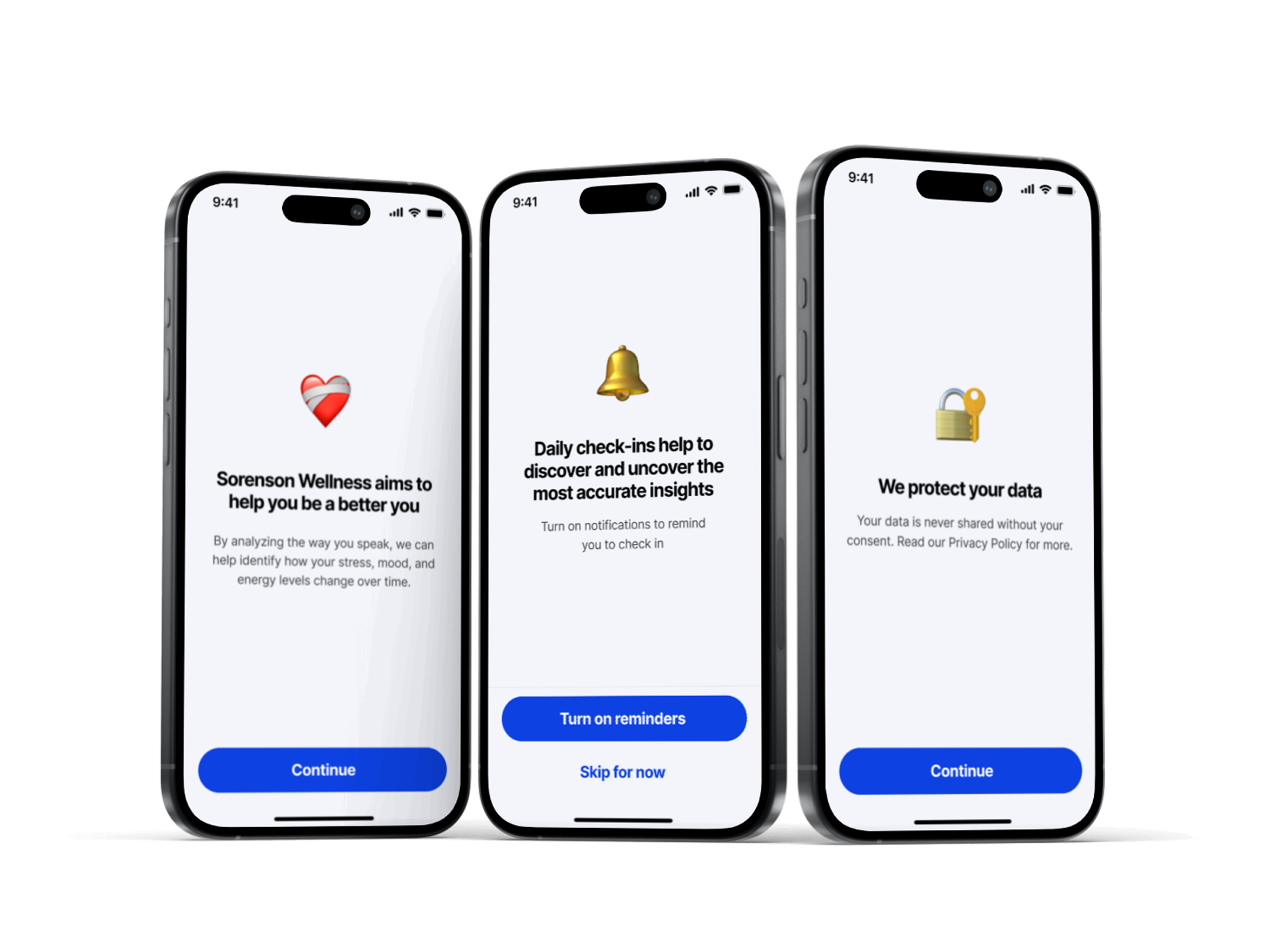
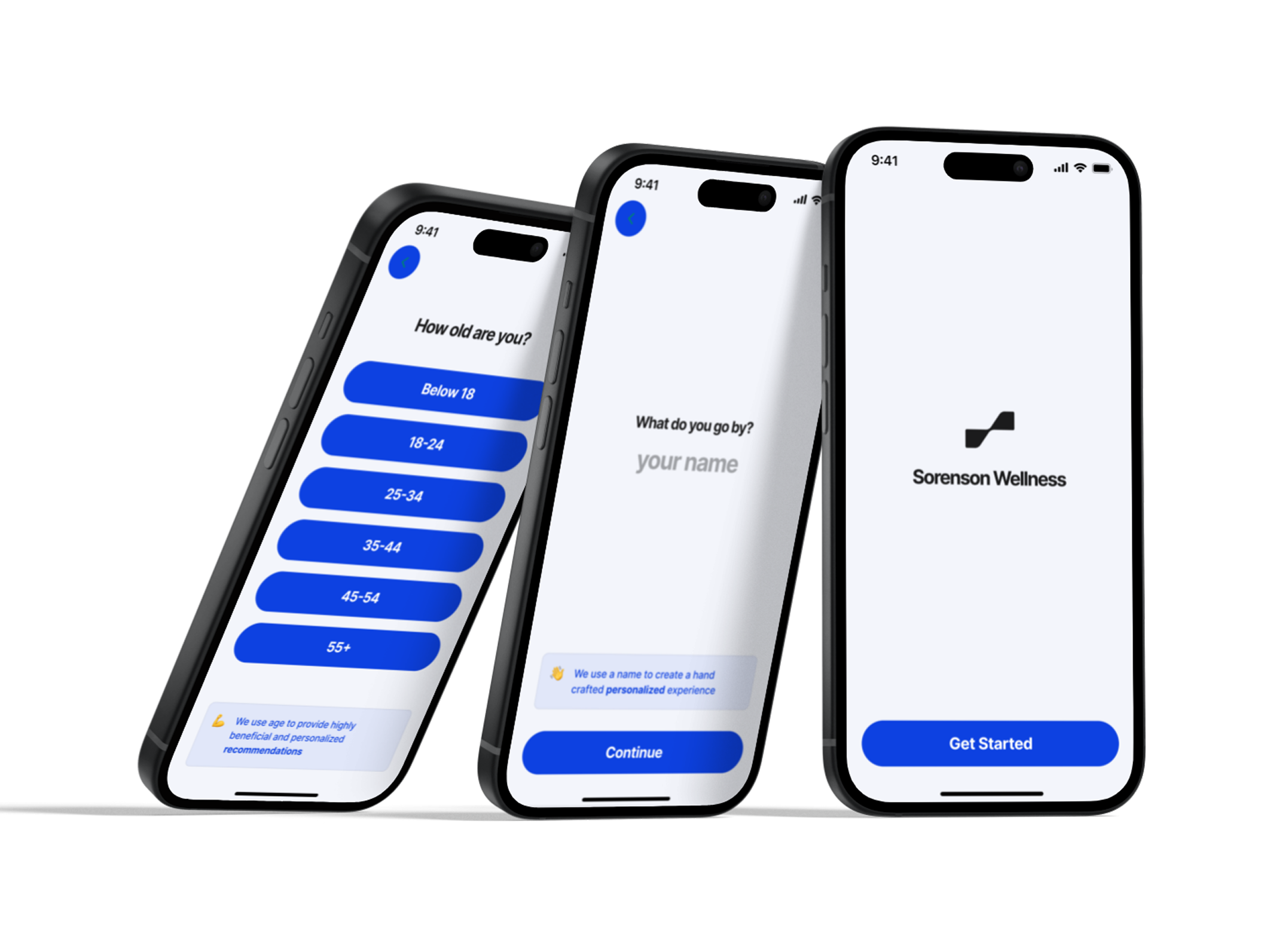
Quiet Space Voice Interface
Challenge: Making voice analysis feel natural and non-intrusive
Solution: Designed calming "Quiet Space" environment for voice interactions
Design Decisions:
- • Soft visual cues during recording
- • Multiple prompt options for user comfort
- • Real-time feedback indicators
- • Immediate insights delivery
Calming Color System:
- • Royal blue primary for trust and calm
- • Neutral grays for minimal distraction
- • High contrast for accessibility
- • Consistent visual hierarchy
Quiet Space Voice Interface Design:
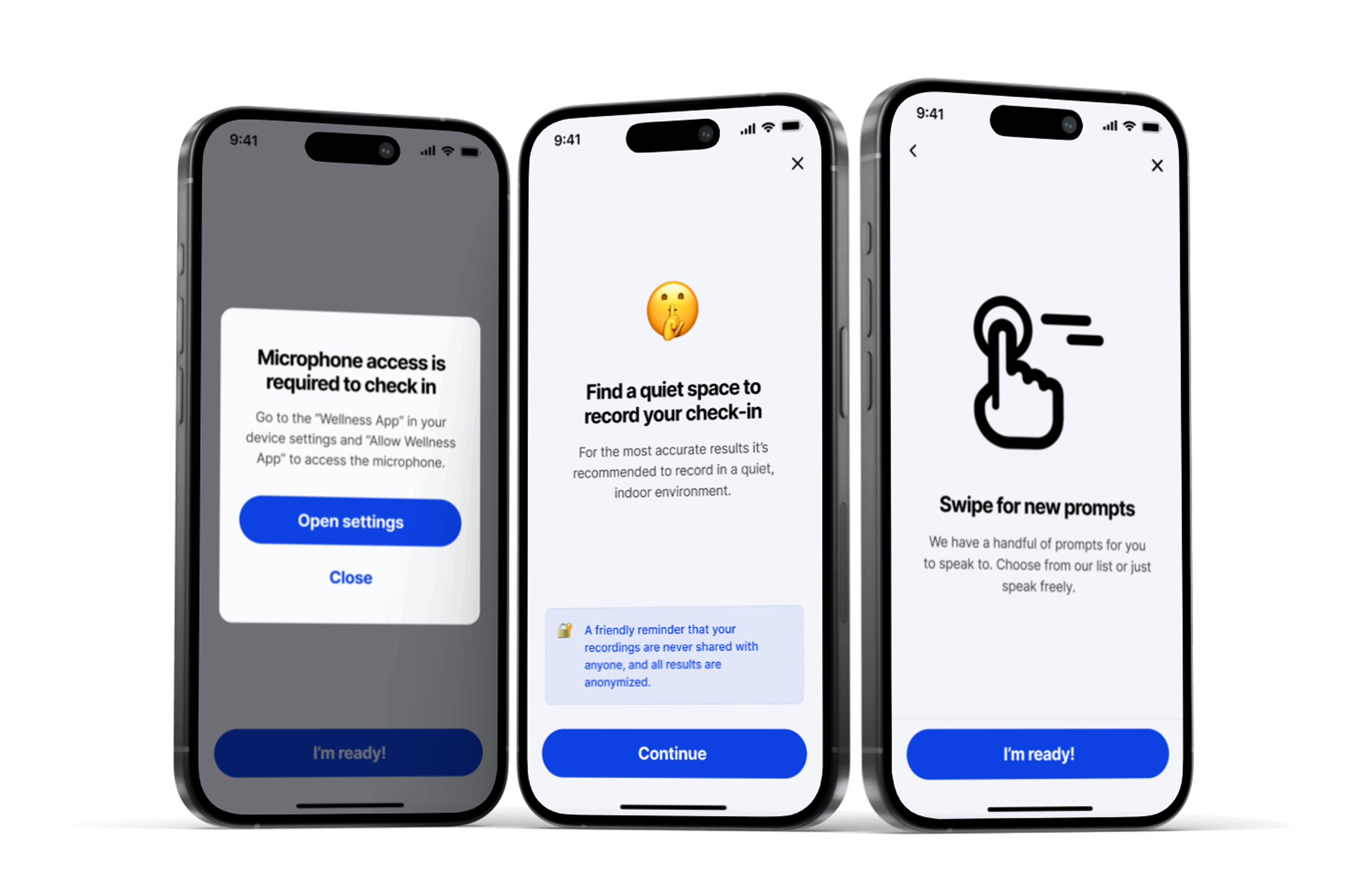

Integrated Mental Health Assessments
Challenge: Combining clinical tools (GAD-7, PHQ-9) with voice analysis
Solution: Seamless integration of validated assessments with voice sentiment data
Design Decisions:
- • Progressive questionnaire design
- • Voice analysis as supplementary data
- • Clear clinical disclaimers
- • Professional referral pathways
Clinical Assessment Interface:
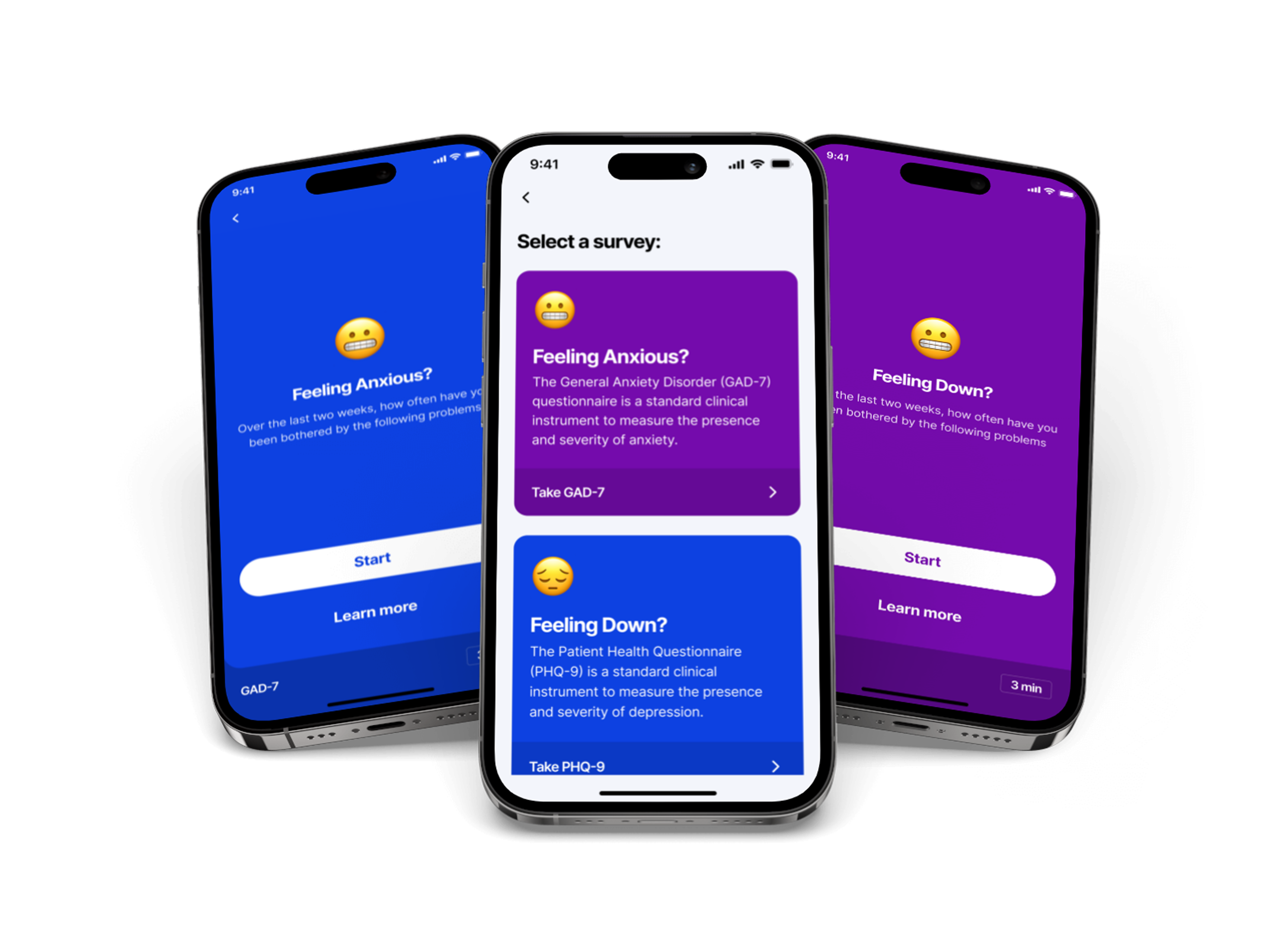
Voice Check-In Flow Wireframes
Challenge: Designing intuitive voice interaction patterns for daily emotional check-ins
Solution: Created mid-resolution wireframes to map the complete voice check-in journey from mood selection to voice recording
Mid-Resolution Wireframe Flow:
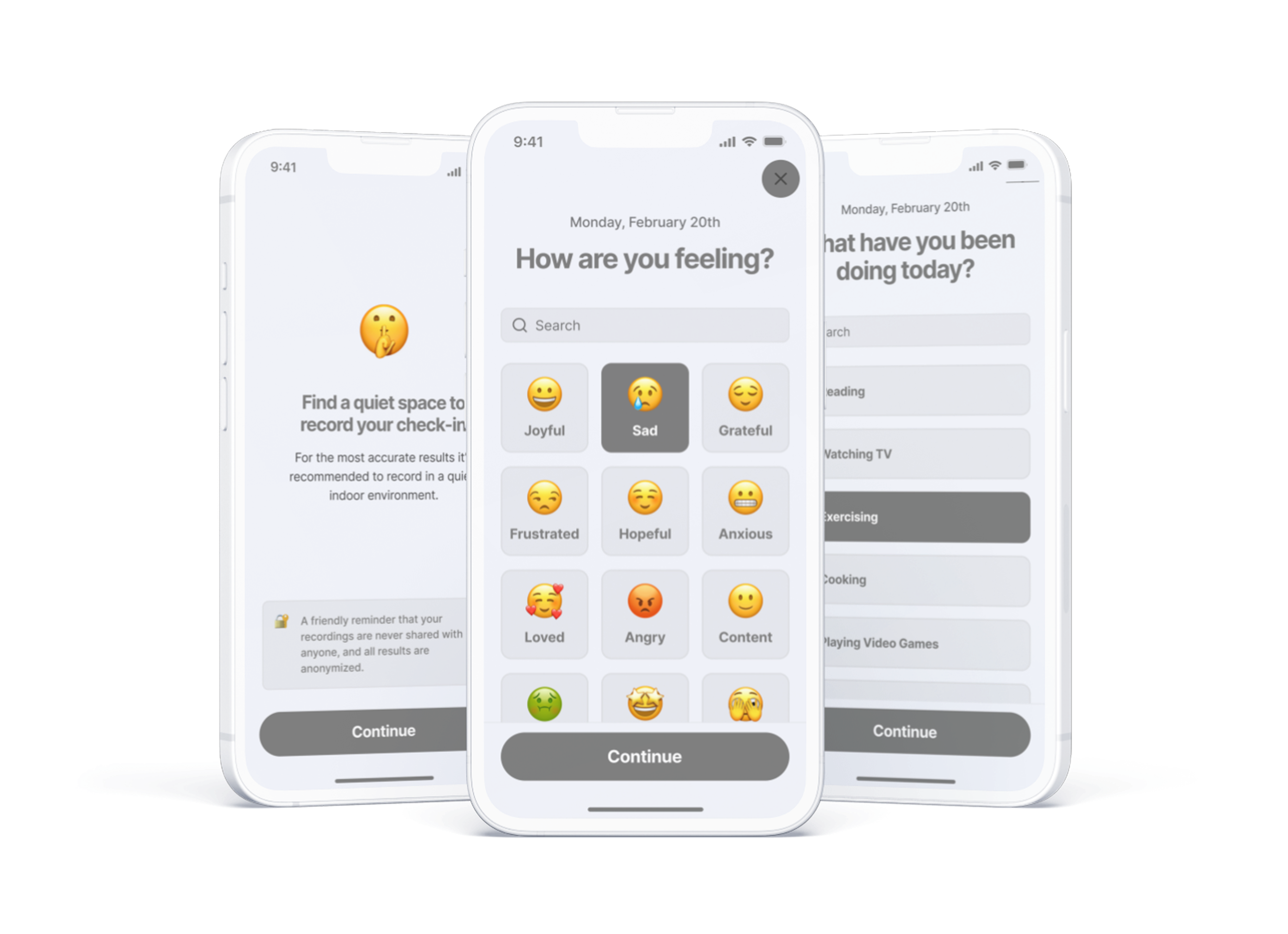
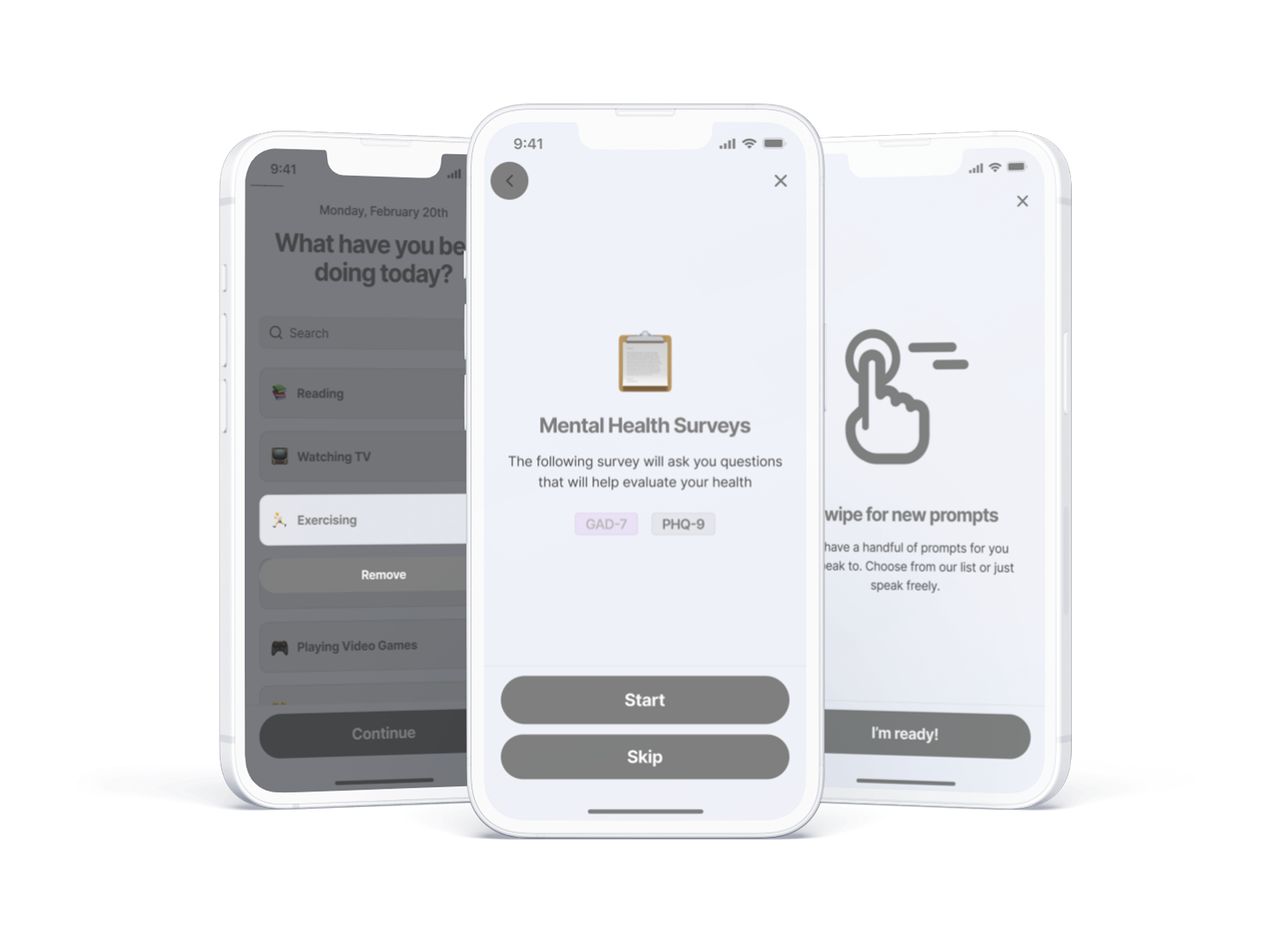
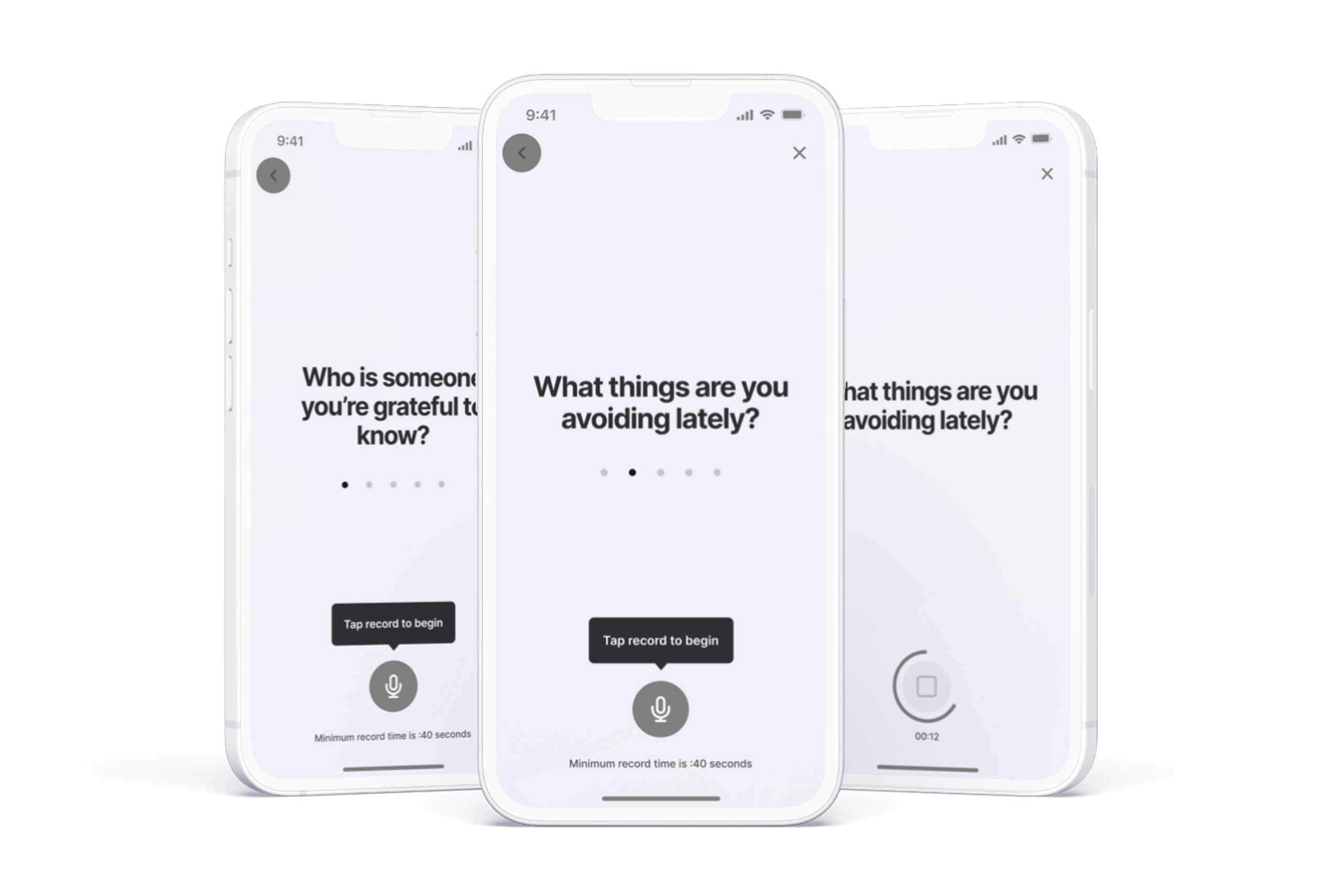
Wireframe Insights:
- • Emotional state mapping through visual selection
- • Progressive disclosure for complex assessments
- • Clear voice recording states and feedback
- • Consistent navigation and exit patterns
Key Design Decisions:
- • Large touch targets for emotional states
- • Skip options at each interaction point
- • Visual progress indicators throughout flow
- • Privacy-focused recording interface
Testing & Validation
Comprehensive usability testing validated the design approach and informed iterative improvements to the voice analysis integration.
Usability Testing Protocol
Results & Metrics
Onboarding Flow Performance
Voice Analysis Acceptance
User Feedback Analysis
Positive Themes
"The voice feature feels natural and actually helpful for tracking my mood"
— Participant #08, Wellness Enthusiast
"I love that it explains why it needs the microphone - feels trustworthy"
— Participant #15, Busy Professional
Concerns Identified
"I understand why it's necessary, but I'm still not comfortable with microphone permissions"
— Participant #03, Wellness Beginner
"Easy to use, but I worry about data being sold"
— Participant #12, Busy Professional
Design Iterations Based on Testing
Enhanced Privacy Communication
Added detailed data usage explanations
Optional Voice Features
Made voice analysis completely optional initially
Gradual Feature Introduction
Implemented progressive disclosure for advanced features
Improved Onboarding Copy
Clarified voice analysis benefits and privacy protections
Impact & Results
The Sorenson Wellness App successfully validated voice analysis integration while achieving all business goals and exceeding user satisfaction targets.
Interactive Prototype
Experience the complete user journey from onboarding through voice analysis. This interactive prototype demonstrates the seamless integration of wellness tracking with voice technology.
UX Metrics Achieved
| Metric | Target | Achieved | Performance |
|---|---|---|---|
| Task Completion Rate | >90% | 100% | 110% of target |
| User Satisfaction | >4.0 | 4.5/5 | 112% of target |
| Onboarding Drop-off | <20% | 0% | Exceeded target |
| Feature Clarity | >3.5 | 3.7/5 | 106% of target |
Business Impact
Strategic Achievements
- Successful MVP validation for voice analysis integration
- Design system foundation established for 2-year product roadmap
- User research framework created for ongoing product development
- Competitive differentiation achieved through innovative voice features
User Experience Improvements
- Reduced app fatigue through holistic wellness approach
- Increased personalization via voice sentiment analysis
- Enhanced privacy transparency building user trust
- Streamlined wellness tracking in single, comprehensive platform
Project Success Metrics
Wellness Assessment A/B Testing Results
Project Overview
Comprehensive A/B testing conducted in September 2023 using Maze to optimize the wellness assessment onboarding flow. Testing compared original 21-screen assessment (Flow A) against redesigned 28-screen assessment (Flow B) across 70 participants.
Test Results Comparison
| Metric | Flow A (Control) | Flow B (Variant) | Improvement |
|---|---|---|---|
| Success Rate | 71.8% | 90.3% | +25% |
| Abandonment Rate | 25.6% | 9.7% | -62% |
| Misclick Rate | 59.8% | 34.4% | -42% |
| Navigation Rating | 4.5/5 | 4.0/5 | Both positive |
Wellness Assessment Coverage (Flow B)
Misclick Rate: 3-7%
Misclick Rate: 13-20%
Misclick Rate: 3-10%
Misclick Rate: 7-10%
Misclick Rate: 3-10%
Misclick Rate: 7%
Misclick Rate: 18%
Misclick Rate: 39-43%
Key Success Factors
- Progressive disclosure improved user flow
- Modern visual design increased engagement
- Comprehensive coverage maintained assessment quality
- Intuitive navigation reduced user errors
Implementation Impact
- 25% increase in assessment completion rates
- 42% reduction in user friction (misclicks)
- 62% decrease in abandonment rates
- Maintained high user satisfaction scores
Recommendation
Deploy Flow B as primary assessment with targeted improvements to occupational wellness section. Continue monitoring long-term completion and satisfaction metrics while addressing identified UX gaps.
Key Learnings & Next Steps
This project provided valuable insights into designing for emerging technologies while maintaining user trust and privacy.
What Worked Well
Privacy-First Approach
Building user trust from the start through transparent communication
Comprehensive User Research
Mixed-methods approach provided strong foundation for design decisions
Iterative Testing
Early and frequent testing caught usability issues before development
Progressive Disclosure
Gradual feature introduction reduced overwhelm and increased adoption
Future Opportunities
Advanced Voice Analytics
Explore deeper emotional analysis and stress pattern recognition
Community Integration
Build social features based on 80% user demand for connections
Wearable Integration
Combine voice analysis with biometric data for holistic insights
AI-Powered Recommendations
Personalize wellness plans based on voice sentiment trends
Technical Recommendations
Implementation Priority
- 1.Establish robust data encryption and privacy protocols
- 2.Build scalable voice processing infrastructure
- 3.Implement comprehensive analytics dashboard
- 4.Develop API ecosystem for future integrations
Design System Evolution
- Expand voice interface component library
- Develop responsive voice interaction patterns
- Create privacy-focused UI component standards
- Establish accessibility guidelines for voice features
Project Reflection
The Sorenson Wellness App project demonstrated that innovative technologies like voice analysis can be successfully integrated into consumer health applications when privacy, transparency, and user education are prioritized. The key to adoption lies not just in the technology itself, but in how it's presented, explained, and integrated into users' existing wellness routines.
Interested in innovative wellness technology?
Let's discuss how user-centered design can make emerging technologies accessible and trustworthy.